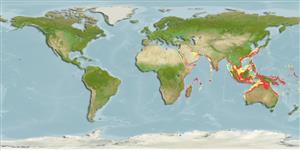Teleostei (teleosts) >
Pleuronectiformes (Flatfishes) >
Cynoglossidae (Tonguefishes) > Cynoglossinae
Etymology: Cynoglossus: Greek, kyon = dog + Greek, odous = teeth + Greek, glossa = tongue (Ref. 45335).
More on author: Richardson.
Environment: milieu / climate zone / depth range / distribution range
Ecology
Marine; freshwater; brackish; demersal; depth range 1 - 140 m (Ref. 9895). Tropical
Indo-West Pacific: India eastward to the Malay Archipelago and the South China Sea, southward to the Philippines and northwest Australia; eastward to New Guinea (Ref. 9895). A related species, Cynoglossus gilchristi Regan, 1920 is recorded from Madagascar, the holotype (BMNH n°1903.9.29:2) being from Natal, off Umlanga River (Ref. 6806).
Size / Weight / Age
Maturity: Lm ? range ? - ? cm
Max length : 35.0 cm SL male/unsexed; (Ref. 48637); common length : 9.0 cm TL male/unsexed; (Ref. 9895)
Dorsal spines (total): 0; Dorsal soft rays (total): 90 - 100; Anal spines: 0; Anal soft rays: 72 - 78; Vertebrae: 44 - 49. Ocular side yellow-brown. Dorsal and anal fins joined to caudal. Eyes both on the left side of the body, a narrow space separating them; asymmetrical mouth; rostral hook below mouth. Ocular side with 2 lateral lines. Only the left ventral fin present (Ref 28). With very irregular dark brown blotches, often forming irregular cross bands. Some rays of dorsal and anal fins dashed with dark brown. Scales ctenoid on both sides of body. Midlateral-line scales 78 to 99. Scale rows between lateral lines on eyed side 15 to 19 (Ref 9895).
Found on the continental shelf over sandy and muddy bottoms. Occurs in the lower courses of flowing rivers and in estuaries (Ref. 12693, 48637). Feeds mostly on benthic invertebrates. Sold fresh, frozen, or dried salted in markets (Ref. 6806).
Life cycle and mating behavior
Maturity | Reproduction | Spawning | Eggs | Fecundity | Larvae
Munroe, T.A., 2001. Cynoglossidae. Tonguesoles. p. 3890-3901. In K.E. Carpenter and V. Niem (eds.) FAO species identification guide for fishery purposes. The living marine resources of the Western Central Pacific. Vol. 6. Bony fishes part 4 (Labridae to Latimeriidae), estuarine crocodiles. FAO, Rome. (Ref. 9895)
IUCN Red List Status (Ref. 130435: Version 2024-2)
Threat to humans
Harmless
Human uses
Fisheries: commercial
Tools
Special reports
Download XML
Internet sources
Estimates based on models
Preferred temperature (Ref.
123201): 24.3 - 29.1, mean 28 °C (based on 2476 cells).
Phylogenetic diversity index (Ref.
82804): PD
50 = 0.5000 [Uniqueness, from 0.5 = low to 2.0 = high].
Bayesian length-weight: a=0.00468 (0.00287 - 0.00762), b=3.13 (2.99 - 3.27), in cm total length, based on LWR estimates for this species & Genus-body shape (Ref.
93245).
Trophic level (Ref.
69278): 3.5 ±0.41 se; based on food items.
Generation time: 1.7 ( na - na) years. Estimated as median ln(3)/K based on 1
growth studies.
Resilience (Ref.
120179): High, minimum population doubling time less than 15 months (K=0.65).
Fishing Vulnerability (Ref.
59153): Low vulnerability (24 of 100).
